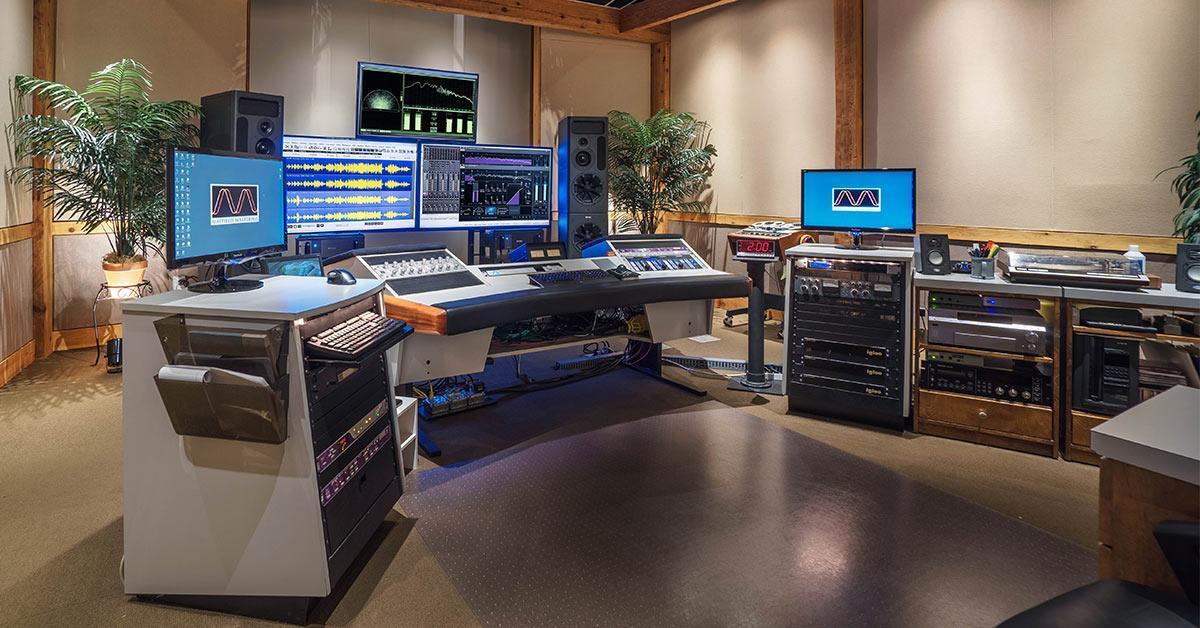Mastering in audio production is the final step of post-production. It ensures the sound is consistent and well-polished across all playback systems.
Mastering involves a series of fine-tuning processes to balance sonic elements of a stereo mix and optimize playback across all media formats and devices. It enhances the overall sound of a track, album, or any audio output to achieve the best possible sound quality.
Audio engineers perform mastering using tools like equalization, compression, limiting, and stereo enhancement. These adjustments provide the finishing touches that can make a track sound professional and cohesive, standing out when played on radios, streaming services, or personal devices. It’s the crucial bridge between mixing and distribution, geared toward making the final product translate well in terms of volume, tone, and dynamics, regardless of where it’s played.
Introduction To Audio Mastering
Audio Mastering is the final step in music production. Think of it as adding polish to a painting. This process balances elements. It ensures consistency across an album. Music gets optimized for playback. That means it sounds good on any device, from a phone to a concert hall. It’s a blend of art and science, completed by a mastering engineer.
Early Roots: The Evolution Of Mastering
Mastering has deep roots. It began with vinyl records. Engineers had to make music play well on a side of a record. This meant balancing levels and EQ. It stopped jumps or skips. Limits existed due to record size and shape. These physical challenges shaped early mastering techniques.
Modern Mastering: A Contemporary Definition
Today, mastering has evolved. The aim is still high-quality sound. But the approach has changed. Digital tools are in play now. They allow precision and control. Engineers focus on crispness and clarity. They ensure volume matches across streaming services. The modern sound must adapt to various listening environments.

Credit: www.sweetwater.com
The Purpose Of Mastering
Mastering stands as the final polish in audio production. Think of it as the last coat of varnish on a beautifully crafted table, enhancing its natural features and ensuring its readiness for display. Mastering fine-tunes the balance, elevation, and cohesion of your audio tracks. It makes sure they sound their best on any system where they might be played. This crucial step ensures your production is professional and competitive in the market.
Polishing Tracks For Final Output
Mastering isn’t just about making music louder. It’s about refinement and clarity. Let’s break it down:
- Enhances overall sound quality
- Removes subtle defects
- Balances audio levels and stereo width
Achieving Sonic Consistency Across An Album
Imagine an album where every song feels part of a bigger story. Mastering ensures your tracks have:
- Uniform volume levels
- Consistent EQ and compression settings
- A harmonious sound character
Preparing Recordings For Distribution
Before music hits the ears of listeners, it must be ready for various formats. Mastering involves:
- Creating multiple format masters: CD, vinyl, streaming
- Embedding ISRC codes for tracking
- Compiling metadata for commercial use
Critical Tools For Mastering
In the world of audio production, mastering is the final step that takes good mixes and transforms them into finished tracks. This process requires critical tools for mastering that ensure the music sounds its best on any platform. One cannot overstate the importance of choosing the right tools for the job.
Essential Software And Hardware
Mastering starts with quality software and hardware. Essential elements include:
- A reliable computer with ample processing power.
- Professional audio software, also known as a Digital Audio Workstation (DAW).
- A high-resolution audio interface for accurate sound reproduction.
- Accurate studio monitors and headphones for critical listening.
The Role Of Compressors, Eqs, And Limiters
Compressors, EQs, and limiters play pivotal roles in mastering. They ensure dynamics and frequency balance across the audio spectrum. Here’s how:
| Tool | Function |
|---|---|
| Compressors | Control the dynamic range and add punch. |
| EQs | Adjust frequencies to refine clarity and tone balance. |
| Limiters | Cap the maximum volume to prevent distortion. |
The Mastering Engineer’s Toolkit
A mastering engineer’s toolkit encompasses a suite of specialized tools to polish a mix. Some key components include:
- Spectral analyzers for visual feedback.
- Metering tools to gauge loudness levels.
- Dynamic processors for tone shaping.
- Dithering tools for converting and preserving audio quality.

Credit: www.izotope.com
The Mastering Process
Audio mastering transforms the final mix into a polished product. It’s the bridge between production and distribution. Mastering gives the track its final gloss, clarity, and ensures it sounds great on all systems. A mastering engineer brings a critical ear, technical skills, and specialized tools to the table. The process is vital for a professional and competitive sound.
Steps In A Typical Mastering Session
- Assessment: Engineers start by listening to tracks closely.
- Sequencing: The order of tracks is arranged for the release.
- Gain Staging: Determines optimal volume levels.
- Processing: Equalization and compression further refine sound.
- Editing: Engineers cut silences and fine-tune starts and ends.
- Formatting: They set up tracks for various distribution formats.
Balancing Frequencies And Dynamics
Ensuring a balance in frequencies and dynamics is a key goal. Mastering engineers use equalizers and compressors. They achieve a consistent sound across tracks.
| Tool | Use |
|---|---|
| Equalizer | Adjusts frequency balance |
| Compressor | Levels out dynamic range |
Enhancing Stereo Width And Ensuring Compatibility
Mastering also involves enhancing stereo width. This makes the sound more immersive. Engineers strive for compatibility across speakers and devices. It is critical to test tracks on different systems. This helps prevent issues in various listening environments.
- Stereo Enhancement: Tools are used to improve spatial depth.
- Compatibility Checks: Tracks are tested on multiple systems.
Challenges In Mastering Audio
The final step in audio production is mastering. It ensures the track sounds great on all devices. Mastering audio can be tough. Many hurdles exist. Experts face varying issues that can make or break a track. Here, we’ll dive into the challenges in mastering audio.
Common Issues And How To Overcome Them
- Uneven EQ levels: Use Equalization to balance the frequency spectrum.
- Dynamic Range Problems: Apply compression wisely to manage peaks and valleys.
- Distortion: Stay below 0 dB to avoid clipping and unwanted noise.
- Inconsistent Volume: Keep levels uniform for smooth listening.
Accurate monitoring and reference tracks are key. They help compare and adjust the audio.
The Loudness War And Its Impact
The loudness war refers to music’s increasing volume over time. This trend often harms the audio quality. Loudness should not compromise dynamics.
Overcoming the loudness war involves:
- Ensuring proper dynamic range.
- Resisting the urge to make the track too loud.
Strive for clarity, not just volume.
Maintaining Artistic Integrity While Mastering
Maintain the original vision of the track. Keep the artist’s intention at the forefront. Collaboration with the artist is crucial.
- Don’t over-process: Use effects sparingly.
- Preserve dynamics: Respect the track’s emotional flow.
- Communicate: Regularly discuss goals with the artist.

Credit: www.landr.com
Future Of Mastering: Looking Ahead
The audio production landscape is always changing. Mastering is evolving too. Today, we dream about tomorrow’s sound. Let’s explore what’s coming.
Innovations Shaping The Industry
New tools and tech are changing how we master audio. Studios are using smarter software. Experts are now working remotely. High-quality sound is getting easier to create.
The Rise Of Ai In Mastering
Artificial Intelligence is becoming a mastering expert. AI software can analyze and fix songs fast. It learns from data. This means quicker, consistent results for artists.
Adapting To New Formats And Delivery Methods
Music now comes in many shapes and sizes. Mastering adapts to this. It might be for a vinyl record, an MP3, or streaming. The aim is perfect sound everywhere.
- High-Resolution Audio: Clearer than before
- Spatial Audio: 3D listening experiences
- Streaming Platforms: Quick, easy access
Frequently Asked Questions For What Is Mastering In Audio Production
What Is Audio Mastering Exactly?
Audio mastering is the final step in music production, where a finished mix is optimized. It ensures uniformity and consistency of sound across an album and enhances overall clarity and quality.
How Does Mastering Differ From Mixing?
Mastering involves refining a final mix, focusing on overall sound. Mixing, however, is the process of combining individual tracks, adjusting levels, and adding effects to create a coherent track.
Can Mastering Improve Recording Quality?
Mastering can enhance the recording’s clarity, balance, and volume. It cannot fix deeply flawed recordings but can significantly improve the sound of well-mixed tracks.
What Tools Are Used In Audio Mastering?
Mastering engineers use a variety of tools including equalizers, compressors, limiters, and stereo imaging techniques to polish and enhance audio tracks.
Conclusion
Mastering is the final touch that brings your audio to life. It ensures your tracks play well across all devices. By emphasizing clarity and consistency, it elevates your music. Remember, professional mastering could make or break a production. Ready to master your sound?
Your audience awaits.